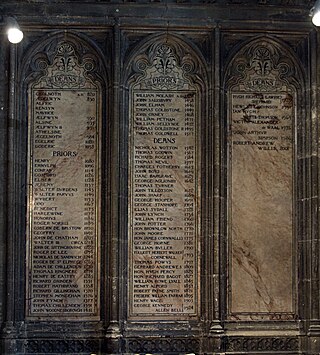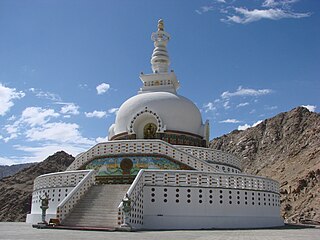Related Research Articles

The Benedictines, officially the Order of Saint Benedict, are a mainly contemplative monastic order of the Catholic Church for men and for women who follow the Rule of Saint Benedict. Initiated in 529 they are the oldest of all the religious orders in the Latin Church. The male religious are also sometimes called the Black Monks, especially in English speaking countries, after the colour of their habits. Not all Benedictines wear black however, with some like the Olivetans wearing white. They were founded by Benedict of Nursia, a 6th-century Italian monk who laid the foundations of Benedictine monasticism through the formulation of his Rule. Benedict's sister, Scholastica, possibly his twin, also became a religious from an early age, but chose to live as a hermit. They retained a close relationship until her death.

The Farne Islands are a group of islands off the coast of Northumberland, England. The group has between 15 and 20 islands depending on the level of the tide. They form an archipelago, divided into the Inner Group and the Outer Group. The main islands in the Inner Group are Inner Farne, Knoxes Reef, the East and West Wideopens, and the Megstone; the main islands in the Outer Group are Staple Island, Brownsman, North and South Wamses, Big Harcar, and Longstone. The two groups are separated by Staple Sound. The highest point, on Inner Farne, is 62 feet (19 m) above mean sea level.

A scriptorium was a writing room in medieval European monasteries for the copying and illuminating of manuscripts by scribes.

The Dean of Canterbury is the head of the Chapter of the Cathedral of Christ Church, Canterbury, England. The current office of Dean originated after the English Reformation, although Deans had also existed before this time; its immediate precursor office was the prior of the cathedral-monastery.

The Tironensian Order or the Order of Tiron was a medieval monastic order named after the location of the mother abbey in the woods of Thiron-Gardais in Perche, some 35 miles west of Chartres in France). They were popularly called "Grey Monks" because of their grey robes, which their spiritual cousins, the monks of Savigny, also wore.

A Peace Pagoda is a Buddhist stupa: a monument to inspire peace, designed to provide a focus for people of all races and creeds, and to help unite them in their search for world peace. Most, though not all, peace pagodas built since World War II have been built under the guidance of Nichidatsu Fujii (1885–1985), a Buddhist monk from Japan and founder of the Nipponzan-Myōhōji Buddhist Order. Fujii was greatly inspired by his meeting with Mahatma Gandhi in 1931 and decided to devote his life to promoting non-violence. In 1947, he began constructing Peace Pagodas as shrines to world peace. The first was inaugurated at Kumamoto in 1954.
Southern Benedictine College was a Catholic Benedictine college and seminary in Cullman, Alabama. Previously called Saint Bernard College, it closed in 1979. Since then, the campus has since been repurposed into St. Bernard Preparatory School by the religious community of Benedictine monks.

Fleury Abbey (Floriacum) in Saint-Benoît-sur-Loire, Loiret, France, founded in about 640, is one of the most celebrated Benedictine monasteries of Western Europe, and possesses the relics of St. Benedict of Nursia. Its site on the banks of the Loire has always made it easily accessible from Orléans, a center of culture unbroken since Roman times. In 2010, the abbey had over forty monks led by the abbot Etienne Ricaud.
Monastic sign languages have been used in Europe from at least the 10th century by Christian monks, and some, such as Cistercian and Trappist sign, are still in use today—not only in Europe, but also in Japan, China and the US. Unlike deaf sign languages, they are better understood as forms of symbolic gestural communication rather than languages, and some writers have preferred to describe them as sign lexicons.

The San Giorgio Monastery is a Benedictine monastery in Venice, Italy, located on the island of San Giorgio Maggiore. It stands next to the Church of San Giorgio Maggiore, which serves the monastic community. Most of the old monastic buildings currently serve as headquarters of the Cini Foundation.

Novalesa Abbey is a Benedictine monastery in the Metropolitan City of Turin, Piedmont, Italy. It was founded in 726, and dedicated to Saint Peter and Saint Andrew.
The Monastery of Our Lady of Jordan was a Strict Observance Cistercian (Trappist) monastery in the community of Jordan in Linn County, Oregon, United States, founded in 1904 and lasting for about six years.

Durham Priory was a Benedictine priory associated with Durham Cathedral, in Durham in the north-east of England. Its head was the Prior of Durham. It was founded in 1083 as a Roman Catholic monastery, but after Dissolution of the Monasteries in 1540 the priory was dissolved and the cathedral was taken over by the Church of England.

Winchester Cathedral Priory was a cathedral monastery attached to Winchester Cathedral, providing the clergy for the church. Cenwealh son of Cynegils is credited with constructing the Old Minster of Winchester in the 640s, and a new bishopric was created in the 660s with Wine as the first bishop. Although attacked by the Vikings in 860 and 879, the monastery survived and recovered.

St Mary Magdalene was a Benedictine priory in Lincoln, England. Along with Sandtoft Priory and Hanes Cell, it was a Lincolnshire cell of St Mary's Abbey in York, England. A surviving building, once owned by the priory, is Monks' Abbey, Lincoln.

The Benedictine Priory, King's Lynn, was a medieval monastery in Norfolk, England. It was founded in 1100 in King's Lynn by Herbert de Losinga, bishop of Norwich, as a small monastic house supporting the church of St Margaret founded at the same time. Its rents and profits were remitted for the use of the priory of the Holy Trinity which served Norwich Cathedral, also founded around the same time by Bishop Herbert. The priory at King's Lynn was lucrative for many years but towards the end of its existence the income from it had fallen to less than the cost of maintaining it.
The Monastery of the Holy Trinity, Crawley Down is an Anglican monastery located at Crawley Down in West Sussex, England.
Saccidananda Ashram is a Camaldolese Benedictine monastery in Tannirpalli, India founded in 1950.

Tokwon Abbey was a Benedictine monastery of the Congregation of Missionary Benedictines of Saint Ottilien, located near the town of Wonsan in what is now North Korea. Founded as a monastic mission in Seoul, the community transferred to Tokwon in the 1920s to take charge of the newly created Apostolic Vicariate of Wonsan. The persecution of Christians in North Korea since 1949 made any church activity in the abbacy impossible. However the Territorial Abbacy of Tokwon is formally still kept as one of the few remaining territorial abbeys within the Catholic Church.
References
- ↑ "Archived copy". Archived from the original on 2009-06-21. Retrieved 2009-08-16.
{{cite web}}: CS1 maint: archived copy as title (link)